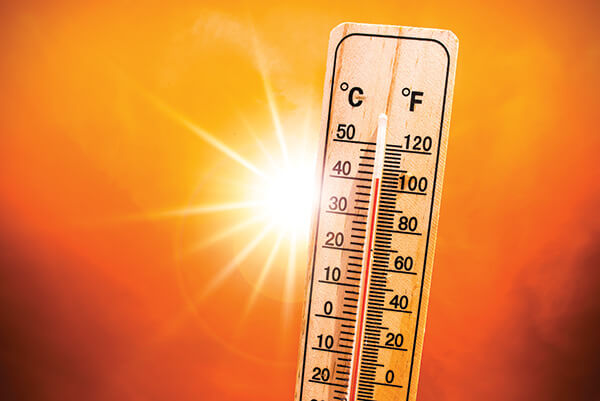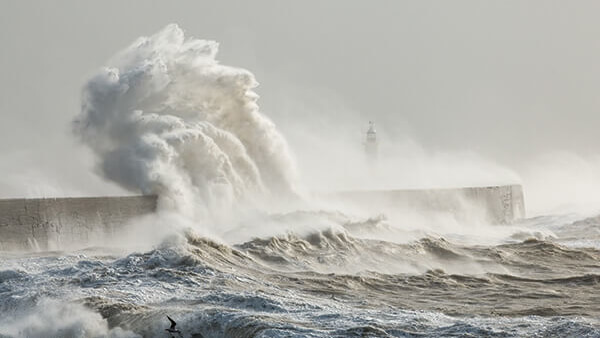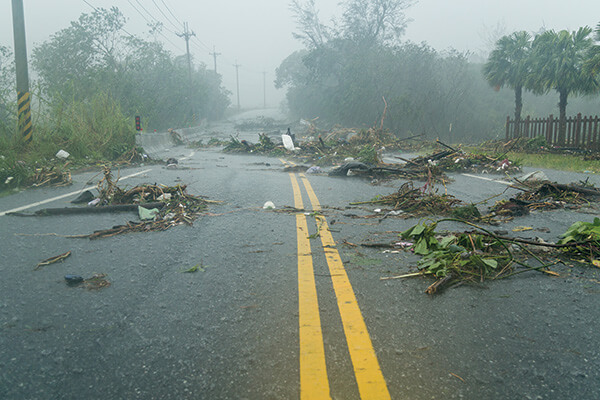If the past two years have taught the bedding industry anything, it’s how to be resilient. While businesses can’t plan for everything, here are some tips for preparing for severe weather

Hurricanes and tropical storms in the Gulf Coast. Wildfires and drought in the West. Hailstorms in Texas and Ohio. A debilitating cold front and winter storm that swept from the center of the country across to the Northeast. Severe thunderstorms and tornado outbreaks in the Midwest and Southeast, including unusually timed tornados and a derecho in December. (We’ll save you the Googling: The National Weather Service describes a derecho as a “widespread, long-lived windstorm” that can have wind speeds similar to a hurricane or tornado.)
Few parts of the United States escaped severe weather in 2021, according to the National Oceanic and Atmospheric Administration. NOAA tallied 20 major “weather/climate disaster events,” each with losses exceeding $1 billion. Together, they resulted in the deaths of 724 people.

And the number of severe weather disasters has been increasing. From 1980-2021, the country averaged 7.7 such events annually. But from 2017-2021, the average more than doubled to 17.8 weather-related disasters each year. Other parts of the world are experiencing similar increases in severe weather, NOAA says.
Even if a business isn’t directly hit by bad weather, it can feel downstream effects.
If you haven’t updated your company’s plans to weather severe storms, now is the time. But here’s a silver lining in recent clouds: The pandemic has made the bedding industry nimbler and more resilient than ever. You can use many of the strategies and practices you put in place since Covid-19’s emergence to help deal with potential weather-related disasters, too.
How threatening is the weather?
How much severe weather affects business is a matter of some debate. First, some sectors are more directly impacted by bad weather than others: Droughts and hailstorms are harder on agriculture than financial services. Second, certain regions, like the Gulf Coast, are more likely to be hit by the types of devastating storms that can destroy buildings, cause prolonged and widespread power outages, and severely damage other infrastructure.
Even if a business isn’t directly hit by bad weather, it can feel downstream effects. Think about the foam shortages and resulting price increases whenever storms significantly impact oil production.
In a recent study, researchers analyzed more than 100,000 annual reports released from 1994-2018 for references to how weather impacted those public companies. Then they correlated those mentions with performance metrics, such as profitability and capital expenditures.
“We showed that the companies that have higher weather exposure are less profitable, they spend more on capital investment and they’re riskier as measured by their returns over 20 years,” says Jordan Schoenfeld of the Tuck School of Business at Dartmouth University in Hanover, New Hampshire. He co-authored the 2020 study with Venky Nagar of the Ross School of Business at the University of Michigan in Ann Arbor.
The study confirms that companies in the utility, energy and food production sectors are more vulnerable to the financial effects of severe weather, as are companies headquartered in the central and southeastern parts of the United States. The researchers also found that big companies, with facilities in several locations, are more likely to feel the impact of weather. That makes sense: If you have 10 plants scattered across the country, they are subject to more threats than a single location.
But, in line with NOAA’s 2021 report, companies overall are experiencing more weather-related business interruptions and financial hits. In 1994, only one-quarter of annual reports mentioned weather, according to Schoenfeld and Nagar’s research. By 2018, the percentage had increased to 65%.
“Companies can’t choose whether to adapt or not,” Schoenfeld says. “They are already adapting, and it’s having big effects.”
3 key risks to mitigate
Insurers recommend reviewing and updating all insurance policies annually and whenever you expand or open new facilities. Boston-based insurance company Liberty Mutual advises businesses to consider how you can mitigate three key risks.
Property damage or destruction:
This may be the first thing that comes to mind when thinking about severe weather — fire from a lightning strike, damaged roofs from a tornado, collapsed structures from a hurricane.
“However, other risks can complicate your property claim,” the insurer says. “Material shortages from supply chain disruption and a shortage of skilled labor in the trades can delay repairs, particularly in situations where much of the region’s infrastructure was damaged. And companies may have to rely on less skilled construction workers, which can lead to construction defect claims.”
In addition to carrying sufficient insurance to deal with making repairs or rebuilding, companies should consider business interruption insurance and should have contingency plans that address possible supply chain and labor shortages. (The Covid-19 pandemic has given the bedding industry a crash course in this.)

Companies overall are experiencing more weather-related business interruptions and financial hits.
Environmental risk:
The biggest weather-related environmental risk is contamination from mold after heavy rainfall and flooding if facilities aren’t cleaned up and repaired quickly and thoroughly, according to Liberty Mutual. “If buildings reopen too quickly without taking adequate time to dry out and repair damages, mold problems may develop, and companies could then be held liable for health risks related to mold exposure,” the insurer warns. Bedding industry suppliers who use chemicals in the production of their components also should have plans to mitigate risks of those chemicals seeping into the environment after a storm.
Casualty risk:
“Severe weather events often push systems to their limit. When those systems fail, businesses and municipalities may be liable for claims relating to property damage, business interruption and even loss of life,” the insurer says. That means having plans in place to deal with the impacts of severe weather. “Leaders should collaborate with their insurance partners to ensure they are addressing all facets of the complex casualty landscape,” Liberty advises.
3 key areas to protect
When you are reviewing and updating plans to survive weather-related disasters, experts advise addressing three areas most vital to your business’ success: people, property and data.
Put people over property:
Create policies and draft plans that keep your employees safe. “Design safe evacuation procedures and designate offsite meeting areas to make it easier to ascertain who is safe and who is missing,” advises The Hartford, an investment and insurance company based in Hartford, Connecticut. Practice both evacuation and shelter-in-place plans semiannually. Depending on where your operations are located, you can time these practices to weather patterns, for instance, the start and end of hurricane season (June/November), or in the early spring ahead of peak tornado outbreaks and again in the late fall before winter storms (March/October.)
As you do for your home and family, provide emergency supplies in all of your locations — water, nonperishable foods, blankets, first aid kits. Be sure to stock up on weather radios, flashlights and lanterns, as well as portable chargers and power packs for employees’ phones. If you operate your own truck fleet, outfit each cab with the same emergency supplies. Check and restock emergency supplies on a schedule similar to your disaster drills.
Because flooding quickly can make roads impassable, determine which roads can provide you and your employees safe routes away from danger and share that evacuation route,” says Jackie Baxley, a professional engineer and corporate director of environmental health safety at HRP Associates Inc., an environmental and engineering consulting firm based in Farmington, Connecticut. A study from the First Street Foundation released in 2021, estimates that 20% of commercial structures in the United States are at risk of serious flooding, as are 2 million miles of roads.
Protect your structures:
Install storm shutters on windows. Invest in surge protectors for electronic equipment, and add generators to provide uninterrupted power, insurers recommend. While tall buildings are most vulnerable to lightning strikes, any building can be at risk. “Installing a lightning protection system device could create a safe path for a lightning bolt to reach the ground, preventing massive danger for your facility, customers and employees,” Baxley says. Keep tarps on hand and, immediately after a storm, inspect the roof for possible leaks.
“Another essential, but often overlooked component of a natural disaster incident is the safe, proper and timely management of debris,” Baxley says. “It is important that disaster debris be properly managed so as to protect human health, comply with regulations, conserve disposal capacity, reduce injuries, and minimize or prevent environmental impacts.”
Secure your records and data:

Records management experts recommend backing up corporate financials, human resources files, supplier and customer records, insurance policies and other vital information using redundant systems, including external hard drives and remote servers through a cloud-based service. Keep videos and photos of machinery, equipment and other assets in an on-site safe and also in a secure off-site location, insurers recommend.
Insurers recommend reviewing and updating all insurance policies annually and whenever you expand or open new facilities.
3 key strategies to put in place
Your contingency plans should include how you’ll operate if a key facility is damaged, and how you’ll communicate with employees, suppliers and customers. Again, this may be a silver lining of the pandemic, as the bedding industry has adjusted in the past two years to remote work, online meetings and other practices that can be employed after a weather-related disaster.
Redundant locations and suppliers:
Your continuity plan should include locations where you could temporarily re-establish administrative and financial functions. These days, that’s likely to be from employees’ homes but it could be a remote workspace or a facility in another part of the country. Also consider how you can shift production if a plant will be closed longer term. After the supply chain problems of the past two years, many bedding companies have expanded their roster of supplier partners. Lists of alternatives are helpful, too, if a supplier has weather-related damage to a facility.
Communication plans:
“In a disaster, if you don’t know what’s going on, the stress level goes way up,” according to The Hartford. “So, it’s important to have several ways to communicate internally and externally.”
Andrea Sayles, previously general manager of business resiliency services for IBM, says, “Your entire organization, from the C-suite to the field technician, should understand their role in the company’s disaster recovery. When everyone knows who is managing what ahead of time, you will have clear channels of communication ready to deploy during an incident.”
When lines are down and cell systems overloaded, you can often turn to texting, which uses less bandwidth. The Hartford recommends mass messaging apps like Text-Em-All and One Call Now that can send alerts to large groups. Use multiple methods to communicate with customers and vendors: email, phone, text, social media.
Testing procedures: Just as schools put students through regular tornado and fire drills, you should regularly test your preparations for weather-related disasters. On the Ready Business section of Ready.gov, you’ll find guides to help you test your plans.
“The best way to know if your company is prepared for future incidents is to repeatedly test your infrastructure in the days and months outside of an actual incident,” Sayles says.
While skies are clear
Prepare now — before the next severe weather event hits your area, experts advise.
In the United States this spring, there already have been outbreaks of damaging thunderstorms and tornadoes, and drought-fueled wildfires in the West. Hurricane season starts June 1 and scientists at Colorado State University predict a busier than average hurricane season with at least 19 named storms and nine hurricanes — four of those major.
“The impact of natural disasters on your business can be catastrophic,” HRP Associates’ Baxley says. “While you cannot fully protect your business against these adversities, you can minimize the risk and damage to your building, equipment and personnel by planning and preparing ahead.” •




